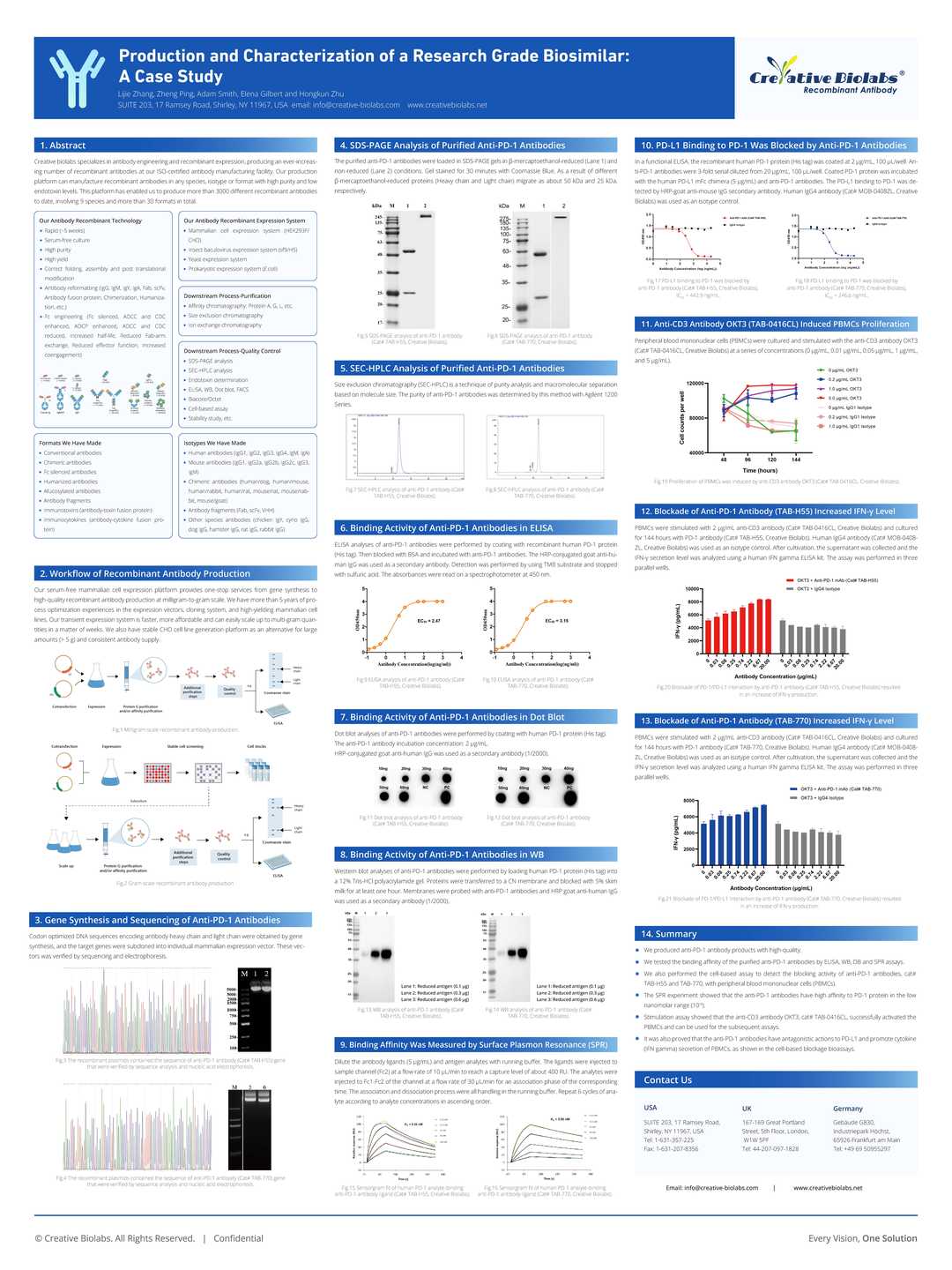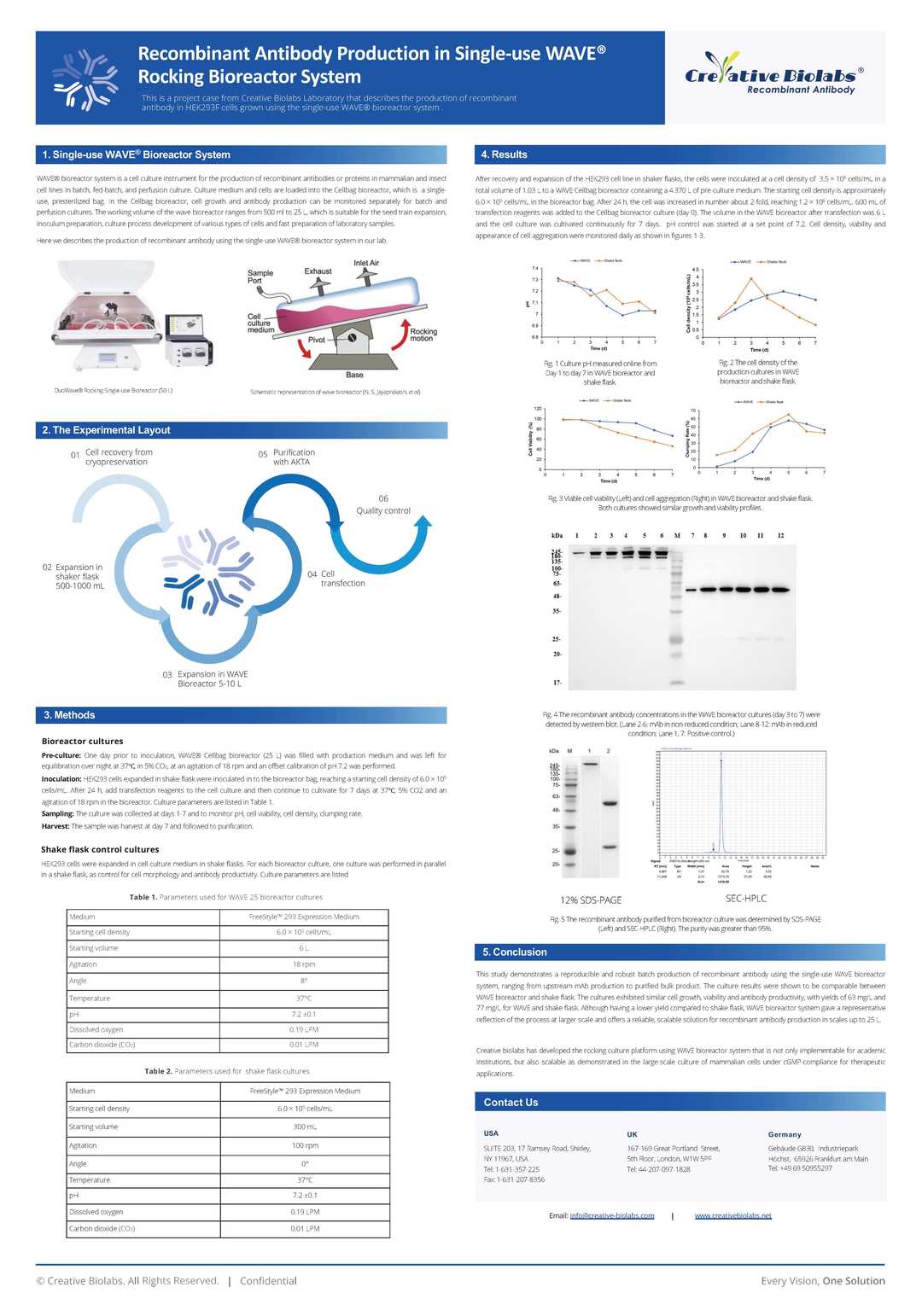Anti-Human GPC3 Single Domain Antibody (TAB-416CQ), Research Grade Biosimilar
CAT#: TAB-416CQ
This antibody binds to a unique conformational epitope in the native form of GPC3 core protein on cancer cells with high affinity. The binding requires both the N-terminus and C-terminus domains of GPC3, and is independent of the HS chains on GPC3.













Specifications
- Host Species
- Human
- Derivation
- Phage display library
- Type
- Single domain antibody
- Specificity
- Human
- Species Reactivity
- Human
- Clone
- TAB-416CQ
- Applications
- Immunoprecipitation, Immunohistochemistry, Functional Assay, Western Blot, ELISA, Inhibition
- Related Disease
- Hepatocellular carcinoma
Applications
- Application Notes
- The antibody was validated for Immunoprecipitation, Immunohistochemistry, Functional Assay, Western Blot, ELISA, Inhibition. For details, refer to Published Data.
Target
Customer Review
There are currently no Customer reviews or questions for TAB-416CQ. Click the button above to contact us or submit your feedback about this product.
Cite This Product
To accurately reference this product in your publication, please use the following citation information:
(Creative Biolabs Cat# TAB-416CQ, RRID: AB_3111929)
Submit Your Publication
Published with our product? Submit your paper and receive a 10% discount on your next order! Share your research to earn exclusive rewards.
Downloadable Resources
Download resources about recombinant antibody development and antibody engineering to boost your research.
Product Notes
This is a product of Creative Biolabs' Hi-Affi™ recombinant antibody portfolio, which has several benefits including:
• Increased sensitivity
• Confirmed specificity
• High repeatability
• Excellent batch-to-batch consistency
• Sustainable supply
• Animal-free production
See more details about Hi-Affi™ recombinant antibody benefits.
Datasheet
MSDS
COA
Certificate of Analysis LookupTo download a Certificate of Analysis, please enter a lot number in the search box below. Note: Certificate of Analysis not available for kit components.
Protocol & Troubleshooting
We have outlined the assay protocols, covering reagents, solutions, procedures, and troubleshooting tips for common issues in order to better assist clients in conducting experiments with our products. View the full list of Protocol & Troubleshooting.
See other products for "GPC3"
Select a product category from the dropdown menu below to view related products.
| CAT | Product Name | Application | Type |
|---|---|---|---|
| NABG-069 | Recombinant Anti-Mouse Gpc3 VHH Single Domain Antibody | WB, ELISA, IHC, FuncS | Llama VHH |
| CAT | Product Name | Application | Type |
|---|---|---|---|
| AGTO-G035E | Anti-Gpc3 immunotoxin (scFv)-PE | Cytotoxicity assay, Function study |
| CAT | Product Name | Application | Type |
|---|---|---|---|
| TAB-152CT | Human Anti-GPC3 Recombinant Antibody (TAB-152CT) | ELISA, FC, IF, WB | Human IgG |
| TAB-154CT | Human Anti-GPC3 Recombinant Antibody (TAB-154CT) | ELISA, FC, IF, WB | Human IgG |
| TAB-156CT | Human Anti-GPC3 Recombinant Antibody (TAB-156CT) | ELISA, FC, IF, WB | Human IgG |
| TAB-167CT | Human Anti-GPC3 Recombinant Antibody (TAB-167CT) | ELISA, FC | Human IgG |
| TAB-168CT | Human Anti-GPC3 Recombinant Antibody (TAB-168CT) | ELISA, FC | Human IgG |
| CAT | Product Name | Application | Type |
|---|---|---|---|
| TAB-157CT | Human Anti-GPC3 Recombinant Antibody (TAB-157CT) | ELISA, FC, IHC, WB | Chimeric (mouse/human) IgG1 |
| TAB-158CT | Human Anti-GPC3 Recombinant Antibody (TAB-158CT) | ELISA, FC, IHC, WB | Chimeric (mouse/human) IgG1 |
| TAB-157CT-S(P) | Mouse Anti-GPC3 Recombinant Antibody; scFv Fragment (TAB-157CT-S(P)) | ELISA, FC, IHC, WB | Mouse scFv |
| TAB-157CT-F(E) | Human Anti-GPC3 Recombinant Antibody; Fab Fragment (TAB-157CT-F(E)) | ELISA, FC, IHC, WB | Chimeric (mouse/human) Fab |
| TAB-158CT-F(E) | Human Anti-GPC3 Recombinant Antibody; Fab Fragment (TAB-158CT-F(E)) | ELISA, FC, IHC, WB | Chimeric (mouse/human) Fab |
| CAT | Product Name | Application | Type |
|---|---|---|---|
| TAB-160CT | Human Anti-GPC3 Recombinant Antibody (TAB-160CT) | FC | Humanized antibody |
| TAB-161CT | Human Anti-GPC3 Recombinant Antibody (TAB-161CT) | FC | Humanized antibody |
| TAB-162CT | Human Anti-GPC3 Recombinant Antibody (TAB-162CT) | FC | Humanized antibody |
| TAB-163CT | Human Anti-GPC3 Recombinant Antibody (TAB-163CT) | FC | Humanized antibody |
| TAB-164CT | Human Anti-GPC3 Recombinant Antibody (TAB-164CT) | FC | Humanized antibody |
| CAT | Product Name | Application | Type |
|---|---|---|---|
| TAB-263CQ | Anti-Human GPC3 Recombinant Antibody (TAB-263CQ) | ELISA, Inhib, IHC | |
| TAB-263CQ-S(P) | Anti-Human GPC3 Recombinant Antibody scFv Fragment (TAB-263CQ-S(P)) | ELISA, WB, FC, IHC | |
| TAB-263CQ-F(E) | Anti-Human GPC3 Recombinant Antibody Fab Fragment (TAB-263CQ-F(E)) | ELISA, WB, FC, IHC |
| CAT | Product Name | Application | Type |
|---|---|---|---|
| MOR-1486 | Hi-Affi™ Rabbit Anti-GPC3 Recombinant Antibody (clone DS1486AB) | IHC-P | Rabbit IgG |
| CAT | Product Name | Application | Type |
|---|---|---|---|
| HPAB-0553-CN-S(P) | Chicken Anti-GPC3 Recombinant Antibody (clone GES1); scFv Fragment | ELISA, FC, IF, IP | Chicken scFv |
| HPAB-0554-CN-S(P) | Human Anti-GPC3 Recombinant Antibody (clone huG5S1); scFv Fragment | ELISA, FC, IF, IP | Humanized scFv |
| HPAB-0689-WJ-S(P) | Human Anti-GPC3 Recombinant Antibody; scFv Fragment (HPAB-0689-WJ-S(P)) | ELISA, FC, WB | Human scFv |
| HPAB-0691-WJ-S(P) | Human Anti-GPC3 Recombinant Antibody; scFv Fragment (HPAB-0691-WJ-S(P)) | ELISA, FC, WB | Human scFv |
| HPAB-0692-WJ-S(P) | Human Anti-GPC3 Recombinant Antibody; scFv Fragment (HPAB-0692-WJ-S(P)) | ELISA, FC, WB | Human scFv |
| CAT | Product Name | Application | Type |
|---|---|---|---|
| HPAB-0553-CN-F(E) | Human Anti-GPC3 Recombinant Antibody (clone GES1); Fab Fragment | ELISA, FC, IF, IP | Human Fab |
| HPAB-0554-CN-F(E) | Human Anti-GPC3 Recombinant Antibody (clone huG5S1); Fab Fragment | ELISA, FC, IF, IP | Humanized Fab |
| HPAB-0556-CN-F(E) | Human Anti-GPC3 Recombinant Antibody; Fab Fragment (HPAB-0556-CN-F(E)) | ELISA, WB | Human Fab |
| HPAB-0558-CN-F(E) | Mouse Anti-GPC3 Recombinant Antibody; Fab Fragment (HPAB-0558-CN-F(E)) | ELISA, WB | Mouse Fab |
| HPAB-0560-CN-F(E) | Mouse Anti-GPC3 Recombinant Antibody; Fab Fragment (HPAB-0560-CN-F(E)) | ELISA, WB | Mouse Fab |
| CAT | Product Name | Application | Type |
|---|---|---|---|
| AFC-TAB-H14 | Afuco™ Anti-GPC3 ADCC Recombinant Antibody, ADCC Enhanced (AFC-TAB-H14) | FuncS, IF, Neut, ELISA, FC, IP | ADCC enhanced antibody |
| CAT | Product Name | Application | Type |
|---|---|---|---|
| HPAB-0449-FY | Mouse Anti-GPC3 Recombinant Antibody (HPAB-0449-FY) | ELISA | Mouse IgG2 |
| FAMAB-1153CQ | Human Anti-GPC3 Recombinant Antibody (clone GC199) | ELISA | Human IgG1 |
| FAMAB-0556WJ | Mouse Anti-GPC3 Recombinant Antibody (clone YP8) | ELISA, WB | Mouse IgG1, κ |
| FAMAB-0557WJ | Mouse Anti-GPC3 Recombinant Antibody (clone YP9) | ELISA, WB | Mouse IgG1, κ |
| FAMAB-0558WJ | Mouse Anti-GPC3 Recombinant Antibody (clone YP9.1) | ELISA, WB | Mouse IgG1, κ |
| CAT | Product Name | Application | Type |
|---|---|---|---|
| VS-0424-XY113 | AbPlus™ Anti-GPC3 Magnetic Beads (huG5S1) | IP, Protein Purification |
| CAT | Product Name | Application | Type |
|---|---|---|---|
| VS-0325-FY182 | Human Anti-GPC3 (clone codrituzumab) scFv-Fc Chimera | IF, Neut, ELISA, FC, IP, ICC | Human IgG1, scFv-Fc |
| CAT | Product Name | Application | Type |
|---|---|---|---|
| VS13-YC459 | CytoStream™ Rabbit Anti-GPC3 Recombinant Antibody (VS13-YC459) | WB, FC | Rabbit IgG |
| CAT | Product Name | Application | Type |
|---|---|---|---|
| VS-0425-YC72 | Recombinant Anti-GPC3 Vesicular Antibody, EV Displayed (VS-0425-YC72) | ELISA, FC, Neut, Cell-uptake |
| CAT | Product Name | Application | Type |
|---|---|---|---|
| VS-0525-XY2880 | Anti-GPC3 Immunohistochemistry Kit | IHC | |
| VS-0525-XY2881 | Anti-Mouse GPC3 Immunohistochemistry Kit | IHC | |
| VS-0525-XY2882 | Anti-Rat GPC3 Immunohistochemistry Kit | IHC |
Popular Products

Application: FC, Cyt, Stim, PP, Agonist

Application: IF, IP, Neut, FuncS, ELISA, FC, WB

Application: FC, IP, ELISA, Neut, FuncS, IF, WB

Application: IP, IF, FuncS, FC, Neut, ELISA, ICC

Application: IP, IF, FuncS, FC, Neut, ELISA, ICC

Application: Neut, ELISA, IF, IP, FuncS, FC, IHC

Application: FC, IHC, FuncS, Inhib, Cyt
-YJ5.png)
Application: WB, ELISA, FC, IHC, IP

Application: ELISA, FuncS, IHC, IF, FC, ADCC

Application: ELISA, IHC, FC, IP, IF, FuncS

Application: ELISA, Inhib, FuncS

Application: ELISA, WB, FC

Application: Neut, IHC, Activ, FuncS, IF, ELISA

Application: FC

Application: ELISA, FC, WB, Inhib, IHC
For research use only. Not intended for any clinical use. No products from Creative Biolabs may be resold, modified for resale or used to manufacture commercial products without prior written approval from Creative Biolabs.
This site is protected by reCAPTCHA and the Google Privacy Policy and Terms of Service apply.

























